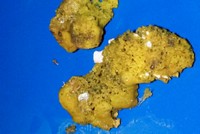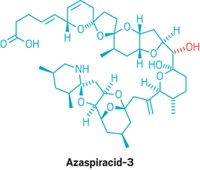Advertisement
Grab your lab coat. Let's get started
Welcome!
Welcome!
Create an account below to get 6 C&EN articles per month, receive newsletters and more - all free.
It seems this is your first time logging in online. Please enter the following information to continue.
As an ACS member you automatically get access to this site. All we need is few more details to create your reading experience.
Not you? Sign in with a different account.
Not you? Sign in with a different account.
ERROR 1
ERROR 1
ERROR 2
ERROR 2
ERROR 2
ERROR 2
ERROR 2
Password and Confirm password must match.
If you have an ACS member number, please enter it here so we can link this account to your membership. (optional)
ERROR 2
ACS values your privacy. By submitting your information, you are gaining access to C&EN and subscribing to our weekly newsletter. We use the information you provide to make your reading experience better, and we will never sell your data to third party members.
Synthesis
Tetrapetalones yield to total synthesis at last
After researchers try for more than a decade, one team succeeds in creating the complex natural products
by Stu Borman
November 1, 2017
| A version of this story appeared in
Volume 95, Issue 44

Several research groups have been trying to synthesize the tetrapetalones, a family of natural products isolated from Streptomyces bacteria, for over a decade. Eighteen students have published dissertations detailing their attempted syntheses. But no one reached the goal—until now. John L. Wood and coworkers at Baylor University have achieved the total synthesis of two family members: tetrapetalones A and C (J. Am. Chem. Soc. 2017, DOI: 10.1021/jacs.7b09358).

“The synthetic challenges offered by molecules like the tetrapetalones push chemists away from conventional problem-solving strategies into unknown territory,” says Alison Frontier of the University of Rochester, leader of the team that previously got closest to synthesizing the natural products. Ever since the first tetrapetalone was isolated and structurally characterized in 2003 by microbiologist Akira Hirota of the University of Shizuoka, in Japan, and coworkers, “many groups have developed synthetic routes that led to dead ends,” Frontier says. “When obvious methods for assembling complex molecules fail, chemists either throw their hands up in despair or they keep inventing, forced to creatively expand the set of options within the context of the problem.”
In the spirit of the latter, she adds, “Wood and coworkers have now devised an ingenious, outside-the-box approach to the synthesis of the tetracyclic tetrapetalone ring system, one that is nothing like the previous synthetic approaches targeting the molecule.”
After isolating the tetrapetalones, Hirota and coworkers showed that the molecules inhibit a plant lipoxygenase that’s similar in structure and function to some human enzymes. The class of compounds could thus help in the discovery of human lipoxygenase inhibitors, which reduce the production of inflammatory leukotrienes and are used to treat asthma. Overall, though, efforts to synthesize the tetrapetalones have been motivated by a fundamental interest in expanding the capabilities of organic synthesis, not by the natural products’ potential as drug leads.
With the amount of effort that has been expended on trying to synthesize the tetrapetalones, “you might think that they cure cancer,” says Thomas Pettus of the University of California, Santa Barbara. “Sadly, this is not the case. They just have a really interesting architecture”—a cyclohexadienone connected to an unusual methyl tetramic acid in a tetracyclic system with lots of stereocenters and a rare β-linked rhodinose sugar. Taken separately, the two principal functional groups, the cyclohexadienone and methyl tetramic acid are unusual, “but when combined, the ensemble is truly remarkable,” he says.
The new synthesis was successful because Wood and coworkers opted to begin it with an N-aryl tetramic acid, which included an ester designed to mask a potentially problematic reactive carbon center, explains Stanford University postdoc Wenju Bai, one of the 18 students to attempt the tetrapetalone synthesis. This strategy avoided unwanted reactivity and enabled the researchers to bring in a pre-formed C–N bond that was difficult to assemble in earlier syntheses. It also eliminated multiple steps needed in previous strategies when the tetramic acid was made later in the synthesis. After making tetrapetalone A, Wood and coworkers oxidized it to tetrapetalone C in one step. Total syntheses of the two tetrapetalones took 18 and 19 steps, respectively, with overall yields of a few tenths of 1%.
Frontier and coworkers had managed to synthesize a methyl derivative of the aglycone, a nearly complete tetrapetalone structure without the β-rhodinose, but they produced too little of it to attempt to add the sugar. The synthesis by Wood’s team “allows preparation of the aglycone on a significantly larger scale, so they could pursue strategies for attaching β-rhodinose,” Frontier says. Wood and coworkers added the sugar to create two diastereomeric intermediates, used chromatography to isolate the one with desired chirality, and unmasked the N-tetramic acid group in the last step.
“The tetrapetalones are deceptively challenging molecules that my group and many others have not been able to synthesize,” comments Richmond Sarpong of the University of California, Berkeley. “Wood and coworkers show that solving the problem rested on masking a tetramic acid, an extremely clever strategy that they applied masterfully. It’s a tour-de-force synthesis—one of the very best I have seen in the last year.”
Wood says his group is currently sending advanced intermediates from the synthesis out for biological testing.





Join the conversation
Contact the reporter
Submit a Letter to the Editor for publication
Engage with us on Twitter